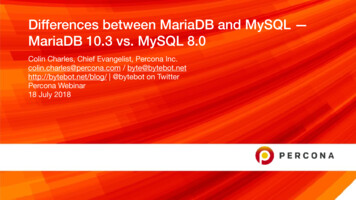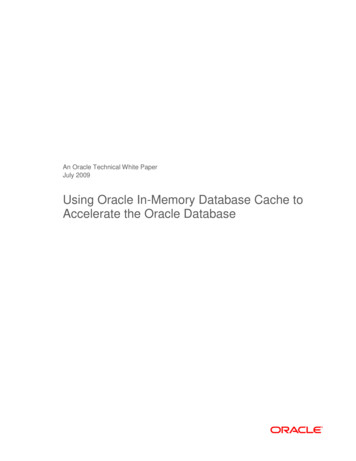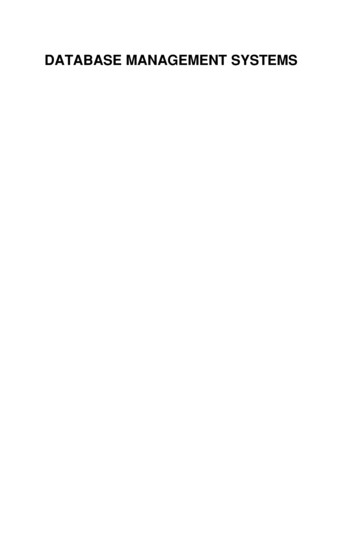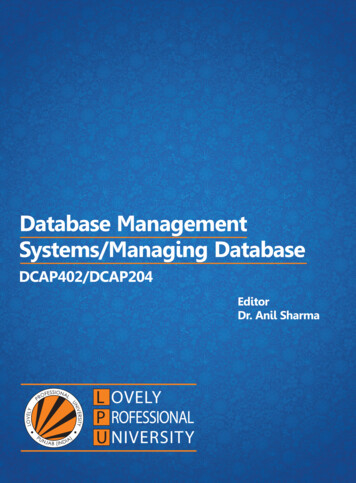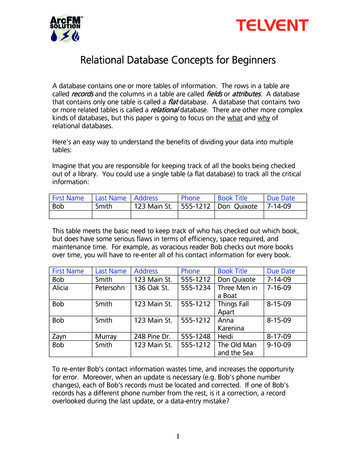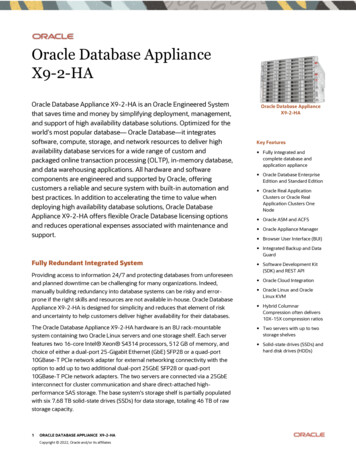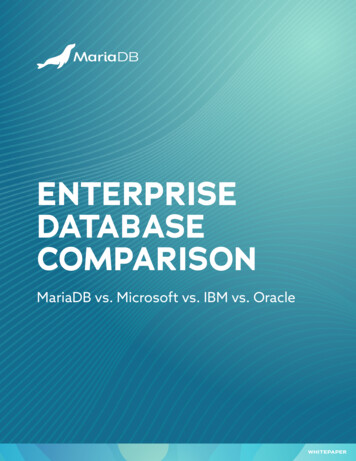
Transcription
ENTERPRISEDATABASECOMPARISONMariaDB vs. Microsoft vs. IBM vs. OracleWHITEPAPER
MARIADB ENTERPRISETransactions and Analytics, UNITEDMariaDB Enterprise is an enterprise open source database for transactional, analytical or hybrid transactional/analyticalprocessing at scale. By preserving historical data and optimizing for real-time analytics while continuing to processtransactions, MariaDB Enterprise provides businesses with the means to create competitive advantages and monetizedata – everything from providing data-driven customers with actionable insight to empowering them with self-serviceanalytics.APPLICATION CONNECTORS(C, JDBC/ODBC and Node.js)BI/REPORTING ATAEXTERNALDATADATAMARIADB MAXSCALEEnterprise Services – Query Routing, Security, High AvailabilityCONNECTORSTRANSACTIONAL (OLTP)ANALYTICAL (OLAP)MariaDB Enterprise ServerMariaDB Enterprise ServerMariaDB Enterprise ServerMariaDB Enterprise ServerAdd DatabaseChange-DataCaptureAdd DatabaseSpark and KafkaInformatica & PentahoC, Java and PythonAdd StorageMariaDB ColumnStoreDistributedClustered / Replicated / Sharded / DistributedON PREMISES OR PUBLIC/PRIVATE/HYBRID CLOUDServersVirtual MachinesKubernetes Helm ChartsDocker ImagesMariaDB ServerMariaDB Server is the foundation of the MariaDB Enterprise. It is the only open source database with the sameenterprise features found in proprietary databases, including Oracle Database compatibility (e.g., PL/SQL compatibility),temporal tables, sharding, point-in-time rollback and transparent data encryption.MariaDB ColumnStoreMariaDB ColumnStore extends MariaDB Server with distributed, columnar storage and massively parallel processingfor ad hoc, interactive analytics on hundreds of billions of rows via standard SQL – with no need to create and maintainindexes, and with 10% of the disk space using high compression.MariaDB MaxScaleMariaDB MaxScale provides MariaDB Enterprise with a set of services for modern applications, including transparentquery routing and change-data-capture for hybrid transactional/analytical workloads, high availability (e.g., automaticfailover) and advanced security (e.g., data masking).Enterprise Database Comparison: MariaDB vs. Microsoft vs. IBM vs. OracleWHITEPAPER
TABLE OF CONTENTS1INTRODUCTION2HIGH AVAILABILITY AND DISASTER RECOVERY4PERFORMANCE, SCALABILITY AND NEnterprise Database Comparison: MariaDB vs. Microsoft vs. IBM vs. OracleWHITEPAPER
INTRODUCTIONThe role of enterprise open source software in modern infrastructure is expanding -the operatingsystem, the middleware, and now, the database. In fact, many organizations have strategicmandates requiring the evaluation of enterprise open source software in order to limit the useof proprietary software. It not only reduces costs and supports the shift from capital expensesto operating expenses, it enables enterprises to benefit from community collaboration andinnovation on a global scale.This white paper compares the leading enterprise open source database, MariaDB Enterprise, with the top threeproprietary databases: Microsoft SQL Server, IBM Db2 and Oracle Database. It does not compare every featureprovided by databases, but rather it focuses on the core enterprise requirements a database must meet in order tosupport mission-critical, business-critical applications: high availability, disaster recovery, performance, scalability,efficiency, security, analytics, schema and SQL.MariaDB became the leading enterprise open source database with the release of MariaDB Platform X3 (the previousnaming convention for MariaDB Enterprise), introducing enterprise features previously only available in proprietaryand expensive databases from Microsoft, IBM and Oracle– temporal tables and queries, distributed partitions (i.e.,sharding), data masking, data obfuscation and Oracle- compatible sequences, data types and stored procedures.This white paper is intended to help database administrators (DBAs), developers and architects understand howMariaDB Enterprise compares with proprietary databases from Microsoft, IBM and Oracle, and how it meets coreenterprise requirements for business as well as operations and development teams.The comparisons are based on Microsoft SQL Server 2017 Enterprise, IBM Db2 Advanced Enterprise Server Edition 11.1for Linux, Unix and Windows (LUW), Oracle Database Enterprise Edition 18c and MariaDB Platform X3.1Enterprise Database Comparison: MariaDB vs. Microsoft vs. IBM vs. OracleWHITEPAPER
HIGH AVAILABILITY ANDDISASTER RECOVERYIn the digital era, databases powering customer-facing web and mobile applications have to be available 24/7, and thustolerate everything from an individual server failure to a whole data center going down. All of these databases canprovide high availability and support disaster recovery, but there are differences in the infrastructure required and theresponsibilities placed on applications.All of these databases can use replication and automatic failover to provide high availability. IBM, Oracle and MariaDBcan use clustering as well, but whereas IBM and Oracle require shared storage for clustering, MariaDB does not. Itimplements a shared-nothing architecture, allowing MariaDB clusters to be deployed on premises or in the cloud wherethere is no shared storage (e.g., SAN).Microsoft and IBM cannot recover sessions and in-flight transactions in the event of an automatic failover, but Oracleand MariaDB can. MariaDB, because it uses an advanced database proxy, can go one step further by migratingconnections whereas Microsoft, IBM and Oracle require applications or clients/drivers to create a new connection.In terms of disaster recovery, all of these databases include backup/restore tools. However, only Oracle and MariaDBcan use point-in-time rollback to recover from errors (e.g., updating the wrong rows) by undoing the most recenttransactions rather than restoring data from backup and applying a subset of the most recent transactions p and restoreYesYesRMANMariaDB BackupPoint-in-time rollbackNoNoOracle FlashbackMariaDB FlashbackReplication with passivestandbysFCIHADRData GuardYesReplication with activestandbysAvailability GroupsSQL ReplicationActive Data Guard*YesClustering with sharedstorageNopureScaleRAC*NoClustering with localstorageNoNoNoMariaDB ClusterConnection migrationNoNoNoYesSession replayNoNoApplication ContinuityYesTransaction replayNoNoApplication ContinuityYes*RAC and Active Data Guard are not included in Oracle Database Enterprise Edition (EE).2Enterprise Database Comparison: MariaDB vs. Microsoft vs. IBM vs. OracleWHITEPAPER
PERFORMANCE, SCALABILITYAND EFFICIENCYThe increased role of online customer engagement has increased the performance, scalability and efficiencyrequirements of databases. They must scale to support business growth, with more customers resulting in moretransactions. Further, they must meet higher and higher performance requirements as customer experiencesexpectations rise. Further, they must do these things as efficiently as possible, and with commodity hardware, inorder to control infrastructure costs.IBM, Oracle and MariaDB can use distributed partitions (i.e., sharding) to scale reads, writes and storage capacity inorder to increase read/write concurrency for greater throughput and lower latency and/or the total amount ofdata that can be stored. Microsoft does not. All of the databases can use compression to improve storage efficiency,storing more data per gigabyte of disk space and reducing disk I/O to store the same amount of data with smaller,fewer and less expensive disk drives.While all of these databases can use a combination of synchronous and asynchronous replication to meetperformance and durability requirements, only MariaDB can use causal reads to ensure consistency when semisynchronous or asynchronous replication is used.FeaturesMSIBMOracleMariaDBLocal partitionsYesTable PartitioningPartitioningYesDistributed partitionsNoDPFOracle Sharding*SpiderColumn compressionNoNoNoYesTable/row compressionYesYesAdvanced Compression**YesIndex compressionYesYesAdvanced Compression**YesBackup compressionYesYesAdvanced Compression**YesQuery parallelizationYesYesYesYesQuery result cachingNoNoYesMariaDB MaxScaleCausal readsNoNoNoMariaDB MaxScale*Sharding may require the Active Data Guard, GoldenGate or RAC add-on for Oracle Database EE.**Advanced Compression is not included in Oracle Database EE.4Enterprise Database Comparison: MariaDB vs. Microsoft vs. IBM vs. OracleWHITEPAPER
SECURITYIn the first half of 2018, companies in every industry – electronics, food and beverage, healthcare, shipping, travel,apparel, retail, finance, transportation, government, communications, education – have suffered data breaches,exposing hundreds of millions of customers’ personal and financial information. In order to prevent data breaches,data must be secured and protected at its source, the database – and that includes preventing malicious queriesfrom reaching the database to begin with.All of the databases can use encryption, roles and dynamic data masking to secure and protect sensitive and/orpersonally identifiable information (SPI/PII) from internal and external threat actors. In addition, all of the databasescan create audit logs for threat monitoring/detection and regulatory compliance. However, only Oracle and MariaDBoffer increased protection via database firewalls, with MariaDB having the world’s most advanced database firewall– capable of blocking queries based on table, column, function as well as role, frequency and time. Further, onlyMariaDB can use result limiting to protect the database from denial of service (DoS) attacks by stopping queriesintended to flood the network and/or slow down the database by returning hundreds of thousands, if not millions, ofrows.FeaturesMSIBMOracleMariaDBSSL/TLS (client-server)YesYesYesYesSSL/TLS (server-server)YesYesYesYesTransparent data encryption (tables)YesYesAdvanced Security*YesTransparent data encryption (logs)YesYesAdvanced Security*YesTransparent data tabase firewallNoNoDatabase Firewall*MariaDB MaxScaleDynamic data maskingYesYesAdvanced Security*MariaDB MaxScaleQuery result limitingNoNoNoMariaDB MaxScaleAuditingYesYesYesYes*Advanced Security and Database Firewall are not included in Oracle Database EE.5Enterprise Database Comparison: MariaDB vs. Microsoft vs. IBM vs. OracleWHITEPAPER
ANALYTICSIn the digital era, innovators in every industry – from finance and healthcare to telecommunications andmanufacturing – are becoming data-centric, analytics-driven organizations. They are delivering actionable insight todecision-makers with modern, on-demand analytics at scale in order to improve customer experience, products andservices, operational efficiency, fraud detection and prevention, and governance, risk management and compliance(GRC) – as well as monetizing data to create new revenue streams.All of the databases can use columnar storage to support high-performance analytics. However, while Oracle islimited to storing columnar data in memory, MariaDB, Microsoft and IBM can store columnar data on disk to supportlarge datasets with lower infrastructure costs. Further, only MariaDB supports distributed data and massivelyparallel processing (MPP) without the need for multimillion-dollar hardware appliances – supporting scalable, highperformance analytics in the cloud or on premises with commodity servers, virtual machines and containers.FeaturesMSIBMOracleMariaDBColumnar storage (in-memory)YesBLU AccelerationDatabase In-Memory*NoColumnar storage (on-disk)YesYesNoYesDistributed storage andprocessingNo**YesNo**YesRAnalysis ServicesDb2 WarehouseAdvanced Analytics*NoCubesAnalysis ServicesDb2 WarehouseOLAP*NoRegression functionsAnalysis ServicesYesYesYes*Database In-Memory, Advanced Analytics and OLAP are not included in Oracle Database EE.**Microsoft and Oracle only support distributed analytics via hardware appliances.6Enterprise Database Comparison: MariaDB vs. Microsoft vs. IBM vs. OracleWHITEPAPER
SCHEMAAll of the databases can use sequences, virtual columns, geospatial data, JSON documents and temporal tables,though MariaDB does not yet support materialized views. MariaDB is the first and only enterprise open sourcedatabase to support system-versioned tables, and while Oracle and IBM support application-versioned tables as well,Microsoft and MariaDB do not. In addition, MariaDB is the only database to support dynamic columns – enablingdifferent rows to store different esYesVirtual/generated columnsYesYesYesYesDynamic columnsNoNoNoYesInvisible columnsYesYesYesYesFunctional indexesYesYesYesYesGeospatial data types (basic)YesYesLocatorYesGeospatial data types(advanced)YesSpatial ExtenderSpatial and Graph*YesJSON data typeYesYesYesYesMaterialized viewsYesYesYesNoSystem-versioned tablesTemporal TablesYesYesYesApplication-table period tablesNoYesYesComing SoonInstant ADD COLUMNYesYesYesYesCHECK constraintsYesYesYesYes*Spatial and Graph is not included in Oracle Database EE.7Enterprise Database Comparison: MariaDB vs. Microsoft vs. IBM vs. OracleWHITEPAPER
SQLAll of the databases support standard SQL: window functions, common table expressions, JSON and geospatialfunctions, set operators (including INTERSECT and EXCEPT), user-defined functions (scalar and aggregate) andtemporal clauses (e.g., AS OF). MariaDB is the first and only enterprise open source database to support point-intime queries with temporal clauses and system-versioned tables.In addition to standard SQL, IBM and MariaDB support Oracle PL/SQL – including sequences, data types, cursors,triggers, stored procedures and packages. MariaDB is the first and only enterprise open source database with Oraclecompatibility.FeaturesMSIBMOracleMariaDBAS OF (point-in-time queries)YesTime Travel QueryFlashback QueryYesPERIOD FOR (temporal validity)NoYesYesComing SoonUNION, INTERSECT and EXCEPT(set operators)YesYesYesYesOVER(window functions)YesYesYesYesWITH(common table expressions)YesYesYesYesJSON functionsYesYesYesYesGeospatial functionsYesYesYesYesUser-defined scalar functionsYesYesYesYesUser-defined aggregate functionsYesYesYesYesStored proceduresTransact-SQLPL/PSMPL/SQLPL/PSMOracle compatibility (e.g., PL/SQL)NoYes–YesEXECUTE IMMEDIATE/EXECUTE(dynamic SQL)YesYesYesYesTable value constructorsYesYesYesYes*Spatial and Graph is not included in Oracle Database EE.8Enterprise Database Comparison: MariaDB vs. Microsoft vs. IBM vs. OracleWHITEPAPER
CONCLUSIONMariaDB Enterprise, like Microsoft SQL Server, IBM Db2 and Oracle Database, meets the coreenterprise requirements of a database for mission-critical, business-critical applications: highavailability, disaster recovery, performance, scalability, efficiency, security, analytics, schema andSQL.However, the architecture of MariaDB Enterprise enables it to run equally as well on containers and public cloudinstances as it does on bare-metal servers – a challenge for databases requiring shared storage for high availabilityand/or scalability (e.g., IBM Db2 with pureScale and Oracle Database with RAC). In addition, it includes the world’smost advanced database proxy featuring a powerful database firewall and denial of service protection.Yet an annual enterprise open source subscription for MariaDB Enterprise is a fraction of the cost of the proprietarylicense and maintenance fees Microsoft, IBM and Oracle charge. In fact, many of the features compared in this whitepaper are not included in an Oracle Database Enterprise Edition license, and must be purchased as separate “addons.” And unlike both Microsoft and Oracle, MariaDB does not require an expensive hardware appliance in order tosupport scalable, high-performance analytics. MariaDB Enterprise can run on commodity servers, virtual machines,containers and cloud instances.MariaDB Enterprise, as the leading enterprise open source database, meets the same core enterprise requirementsas Microsoft SQL Server, IBM Db2 and Oracle Database, but at a fraction of the cost and with an annual subscription –and with built-in Oracle compatibility, it’s never been easier to migrate from Oracle Database.It’s time to break free from proprietary databases. It’s time to evaluate MariaDB Enterprise.9Enterprise Database Comparison: MariaDB vs. Microsoft vs. IBM vs. OracleWHITEPAPER
and MariaDB can. MariaDB, because it uses an advanced database proxy, can go one step further by migrating connections whereas Microsoft, IBM and Oracle require applications or clients/drivers to create a new connection. In terms of disaster recovery, all of these databases include backup/restore tools. However, only Oracle and MariaDB
